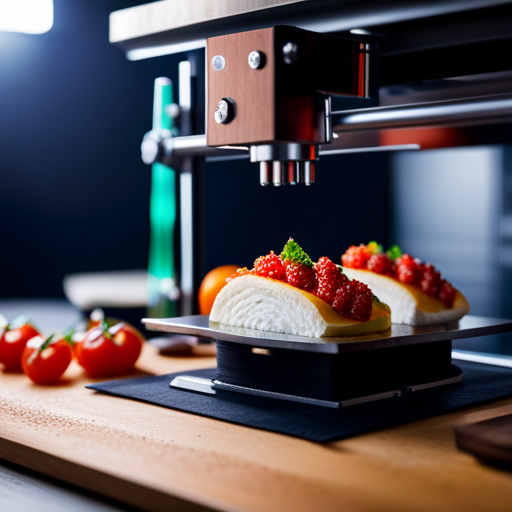In the ever-evolving landscape of culinary technology, the intersection of international markets and food 3D printing presents both unprecedented opportunities and complex challenges.
As traditional culinary practices intersect with cutting-edge innovation, cultural nuances and regulatory landscapes must be carefully navigated.
This article delves into the strategic considerations and market dynamics essential for successful international expansion in the realm of food 3D printing, shedding light on the multifaceted landscape of global culinary innovation.
Global Adoption of Food 3D Printing
The global adoption of food 3D printing is gaining momentum as food technology continues to advance and consumer demand for personalized and sustainable food options grows. Technological advancements have paved the way for 3D printing to revolutionize the food industry, allowing for the creation of intricate and customized food products. This has sparked international partnerships between technology companies, food manufacturers, and culinary experts to further develop and commercialize food 3D printing technology. These collaborations have led to the creation of sophisticated 3D food printers capable of producing a wide range of food items, from intricate confectionary designs to plant-based meat alternatives.
Furthermore, international partnerships have facilitated the exchange of expertise and resources, leading to the exploration of new markets for food 3D printing technology. As a result, this innovative technology is not only being embraced in technologically advanced countries but also in emerging economies where there is a growing demand for sustainable and customizable food solutions.
The global adoption of food 3D printing is not only reshaping the way food is produced and consumed but also paving the way for a more sustainable and personalized approach to food manufacturing on a global scale.
Cultural Considerations in Culinary Innovation
One key determinant in culinary innovation, particularly in the context of international markets for food 3D printing, is the consideration of cultural nuances and preferences.
Cultural adaptation is essential when introducing 3D printed food products in diverse global markets. Different regions have unique culinary traditions, dietary habits, and flavor preferences, which must be carefully taken into account.
For instance, while some cultures may prefer spicy and bold flavors, others may have a preference for milder tastes. This necessitates a thorough understanding of local palates and the incorporation of region-specific ingredients and flavors into 3D printed food offerings.
Moreover, cultural considerations extend beyond flavor profiles to encompass religious dietary restrictions, ethical food practices, and traditional food symbolism. Respect for these cultural elements is crucial for the successful integration of food 3D printing technology into international markets.
Market Potential and Consumer Demand
Exploring the market potential and consumer demand for food 3D printing is crucial for understanding the feasibility and acceptance of this innovative technology on a global scale. The adoption of food 3D printing is heavily reliant on consumer behavior and the existing market dynamics. To comprehend the current and potential demand for 3D printed food, a comprehensive market analysis is essential.
-
Consumer Behavior Considerations
-
Consumer Preferences: Understanding the preferences of consumers in different regions is vital. Factors such as taste, texture, nutritional value, and cultural significance of food play a significant role in consumer decision-making.
-
Acceptance of Novel Technologies: Analyzing consumer receptiveness to innovative culinary technologies is crucial. It is important to assess the willingness of consumers to embrace 3D printed food and the factors that influence their acceptance.
-
Market Analysis
-
Global Market Assessment: Evaluating the current state of the food industry in various countries and regions to identify potential markets for food 3D printing.
-
Competitive Landscape: Analyzing the existing competition and identifying opportunities for food 3D printing within the broader food industry.
Regulatory Hurdles and Legal Implications
Navigating the global landscape of food 3D printing involves confronting regulatory hurdles and legal implications that directly impact market entry and consumer acceptance. When venturing into international markets, companies engaging in food 3D printing must ensure regulatory compliance and consider the food safety implications of their products. The table below provides an overview of key regulatory considerations and legal implications for food 3D printing in international markets:
| Regulatory Considerations | Legal Implications |
|---|---|
| Compliance with food safety standards and regulations | Intellectual property protection for 3D printed food products |
| Labeling requirements for 3D printed food items | Liability for any adverse health effects from consuming 3D printed food |
| Import/export restrictions on 3D printed food | Compliance with local manufacturing and food production regulations |
| Approval and certification processes for 3D printed food technology | Contractual agreements and disputes related to 3D printed food production |
Ensuring adherence to these regulatory and legal aspects is crucial for the successful expansion of food 3D printing into international markets while maintaining consumer trust and confidence in the safety and quality of 3D printed food products.
Strategies for Successful International Expansion
Implementing effective strategies for successful international expansion of food 3D printing requires thorough market research and strategic partnerships with local distributors and regulatory authorities to navigate complex global regulations and ensure compliance.
-
Market Analysis
-
Conduct comprehensive market analysis to identify the demand for 3D printed food products in different regions. Consider factors such as consumer preferences, dietary habits, and cultural considerations to tailor products to specific markets. Utilize market research data to understand the competitive landscape and adapt the product offerings to meet the unique needs of each market.
-
Distribution Channels
-
Establish strong relationships with local distributors to streamline the distribution process and ensure efficient market penetration. Evaluate the most effective distribution channels in each target market, considering factors such as transportation infrastructure, retail networks, and e-commerce platforms. Tailor distribution strategies to align with the preferences and behaviors of the local consumer base, ensuring accessibility and visibility of 3D printed food products.
Frequently Asked Questions
Can Food 3D Printing Technology Be Customized to Cater to Specific Dietary Restrictions or Cultural Preferences in Different International Markets?
Customizing food 3D printing for diverse dietary needs and cultural preferences is essential for international adoption. This addresses market niches and enhances consumer acceptance. Understanding these nuances is critical for successful expansion into global markets.
How Do Cultural Attitudes Towards Technology and Food Innovation Impact the Adoption of 3D Printed Food in Different Countries?
Cultural attitudes towards technology and food innovation significantly impact the international adoption of 3D printed food. Understanding dietary restrictions, market niches, regulatory challenges, and successful case studies is crucial for international expansion, along with addressing legal considerations.
Are There Any Unique Market Niches or Untapped Consumer Demands for 3D Printed Food Products in Specific International Markets?
Unique consumer demands and market niches for 3D printed food products exist in international markets due to cultural customization and dietary restrictions. Identifying and catering to these specific needs can unlock untapped potential for food 3D printing.
What Are the Specific Regulatory Challenges and Legal Considerations That Food 3D Printing Companies Face When Entering International Markets?
Navigating international markets presents food 3D printing companies with a myriad of regulatory challenges and legal considerations. These encompass compliance with diverse food safety standards, intellectual property protection, and varying import/export regulations, necessitating meticulous strategic planning and legal expertise.
What Are Some Successful Case Studies or Best Practices for Navigating Cultural and Regulatory Barriers in International Expansion for Food 3D Printing Companies?
Successful case studies demonstrate how food 3D printing companies navigated cultural and regulatory barriers in international expansion. Through regulatory compliance, cultural customization, and targeting specific market niches, companies achieved global success and overcame challenges in new markets.
Conclusion
The global adoption of food 3D printing presents a promising opportunity for international expansion. However, cultural considerations, market potential, and regulatory hurdles must be carefully navigated.
By understanding the complexities of culinary innovation and consumer demand, companies can develop successful strategies for entering new international markets.
Despite the legal implications and challenges, the potential for growth and innovation in the food 3D printing industry is undeniable.


